Pattern Continues 2nd Grade Using Race Method
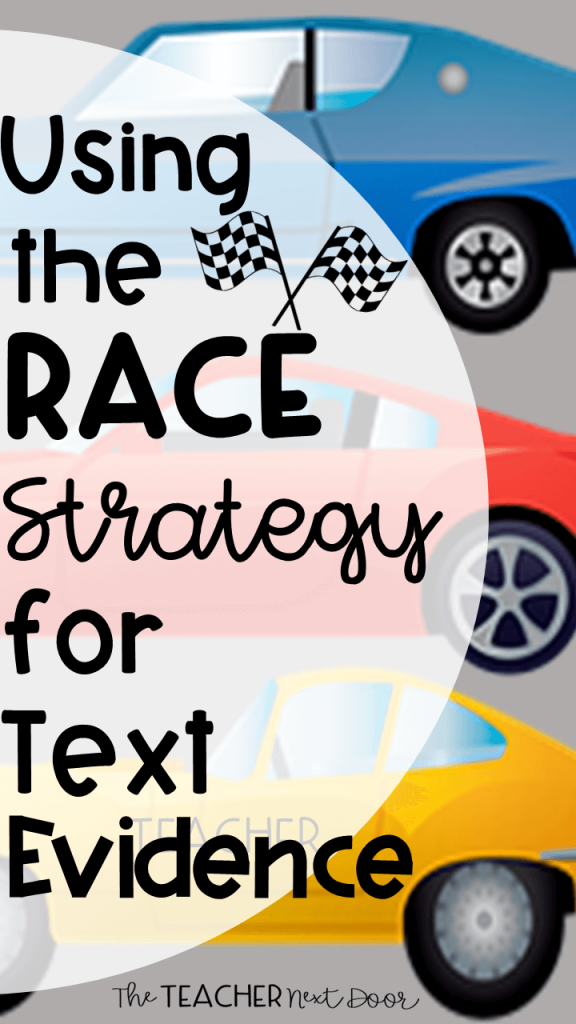
Constructed response questions can be scary at first…scary to teach and scary to actually write! I mean, when you compare writing a constructed response to answering a multiple choice question, well…there really is no comparison. It makes multiple choice questions seem so simple to complete.
Since we know that students need to be able to write constructed responses, I was so happy when I was introduced to the RACE strategy. It took the scare out of teaching constructed responses for text evidence. It gave me a step-by-step template to teach my students exactly what to do.
Even though writing constructed responses are still challenging, when you teach your students the RACE strategy and give them lots of opportunities for practice, your students will master it!
So, just what is the RACE strategy? RACE is an acronym that helps students remember which steps and in which order to write a constructed response.
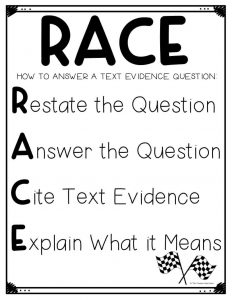
R = Restate the Question
The first step is to change the question into a statement. Students need to remove the question word like who, what, when, where, or why but restate the keywords in the question.
For example, if the question was "Why did Jill decide to give her mother a jewelry box?" the answer would start this way, "Jill decided to give her mother a jewelry box because…"
A = Answer the Question
After restating the question, the second step is to finish the sentence and answer the question. Students may use their own knowledge as well as inferences from the text to identify the answer.
A few tips for this…Number one, it's important that they make sure to answer the specific question being asked. Number two, they also need to answer every part of the question. Sometimes questions have more than one part. Finally, they need to list the character's name first, before using a pronoun like he/she/they.
C = Cite Text Evidence
This is the tricky part. First kids need to find relevant evidence to support their answer. Then they need to write it correctly using a sentence stem, like… According to the text… or The author stated… or In the second paragraph, the author mentioned… or On the third page, the text stated… or Based on the text… and so on.
I make an anchor chart with these stems and put them up when we're first starting to work on citing evidence. Once kids get a few of these memorized, it makes this part of the RACE strategy go much more smoothly. I do make sure students know to quote the text exactly as it is written and to use quotation marks correctly too.
E = Explain What it Means
The last part of the constructed response is where kids tell how their text evidence proved their point. Again, some simple sentence starters help kids stay on track here. Those include…This shows… or This proves… or This is a good example of… or This means that… and so on.
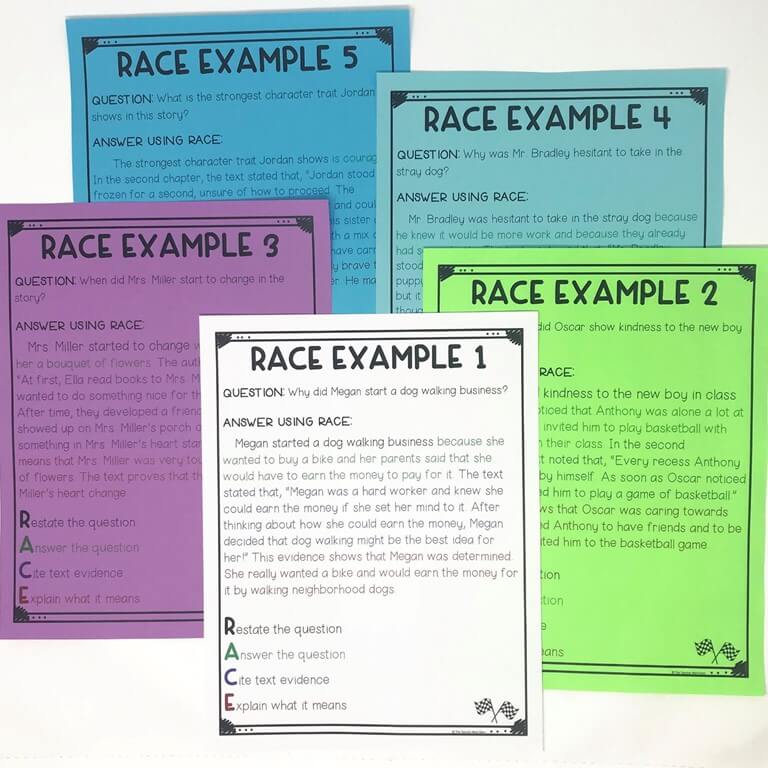
When I teach the RACE strategy, I like to give the kids an overview of a completed constructed response example, so they can see where we're going. Then I break it down into separate parts to teach each one before putting it all together.
By the time kids reach me in fourth or fifth grade, the majority of students at my school have had teachers who have required them to answer a question using a restatement. They aren't doing constructed responses yet, but most of them are fairly comfortable with at least the restating part.
So, I might spend a few days teaching or reviewing the restating and answering part. I do teach the restating and the answering together since they usually form one single sentence. Then I move to cite text evidence, which takes a lot longer to teach. The explaining part goes fairly quickly after that.
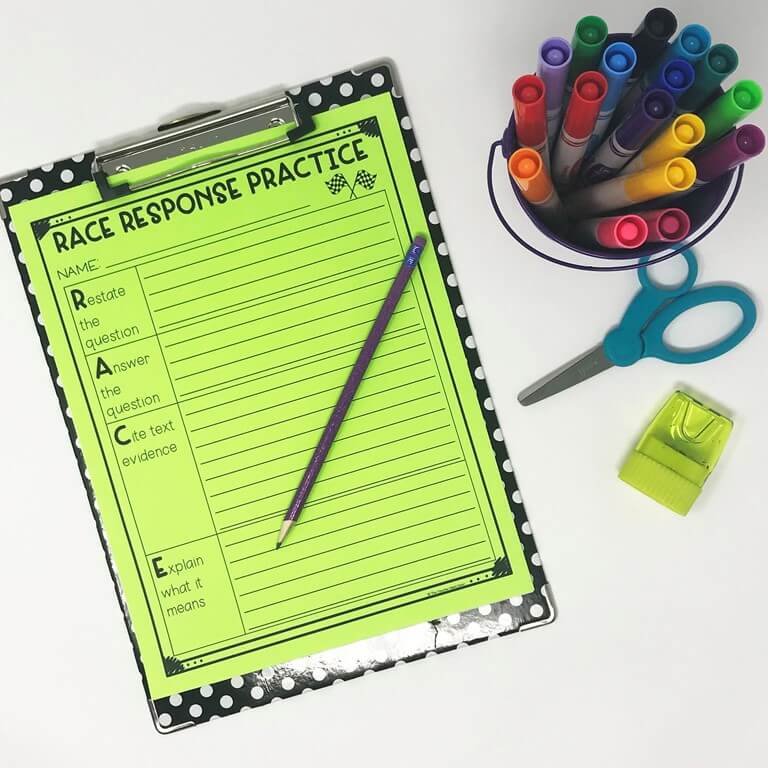
Once we've done all of the components, it's time to practice putting it all together. We read a short piece of text as a class. It might be a Scholastic News article, a page from Chicken Soup for the Soul, or a passage I've created.
Then I model (with their input) a constructed response using a RACE template (from the Text Evidence Kit). I project it on the smartboard so everyone can see.
The next day we do this again with a different passage in pairs. When they're finished, we go over it together to compare notes when they're finished. After that, it is time to work on it independently.
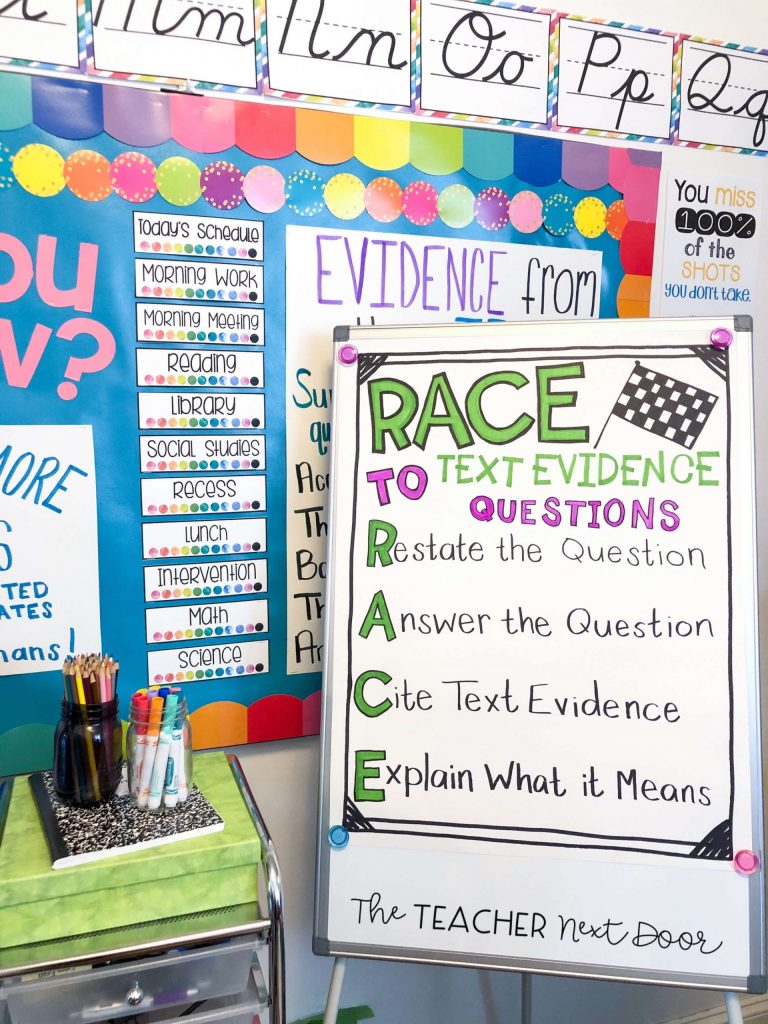
A few notes…
- Make sure to start teaching the RACE strategy fairly early in the year, so there's plenty of time to practice it. Starting right before testing is not going to be very effective.
- Do start with short passages. One page is ideal in my mind. Giving students practice with shorter texts will help them gain confidence for the longer texts to come. Baby steps, right?
- You'll want to have students write constructed responses repeatedly, but NOT for every passage and NOT every day! Constructed responses are somewhat of a chore, even with an awesome strategy like RACE.
- I try not to burn kids out on any one thing so that they dread it. It would be like asking them to write a five-paragraph essay each day. No one wants to do that. So, my advice is to give them a good foundation for how to write them and then sprinkle them in every now and then throughout the year. The spiral is key!
Of course, you can gather all of your own materials to teach students to write constructed responses, but if you'd like a time-saving set of materials, I do have a Text Evidence Kit you might like! It has 10 color coding passages, 8 practice passages, 3 sets of text evidence games (with 32 task cards in each set), plus posters for RACE! By the way, the entire unit is already differentiated for you! Each passage comes in three different levels and the three games are differentiated too!
Click here to check this unit out!
I also have another Text Evidence unit I use for extra practice and it includes both print AND digital formats! It has lots of passages (2 are color coding) and a set of task cards too.
Click here to take a peek!

Want a Text Evidence Game? This one is great for centers!
Click here to check out the 4th/5th Text Evidence Game!
If you're looking for digital activities, these reading units can be completed in Google Slides or in PowerPoint. They're super interactive and are fun for students while hitting standards.
Click here to take a look at the 4th Grade Digital Reading Text Evidence Unit
Click here to take a look at the 5th Grade Digital Reading Text Evidence Unit
Finally, if you'd like to read more about how to teach text evidence, I wrote a post you might want to read too:
Citing Text Evidence in 6 Steps.
Thanks so much for stopping by!
Jenn – The Teacher Next Door

wedgwoodowbet1957.blogspot.com
Source: https://the-teacher-next-door.com/using-the-race-strategy-for-text-evidence/